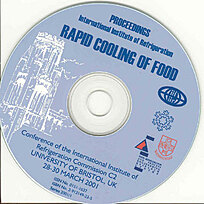
Summary
In conventional designs of air blast tunnels, the use of high velocity air to reduce freezing times is restricted because normally the same volume of air circulates through the evaporator coil and then across the product. The air velocity over the product is determined by the ratio of the evaporator's face velocity to the free area across the product. Generally, the pressure drop across the evaporator is dominant in the overall pressure drop and therefore restricts the volume of air in circulation. To achieve an economical balance in absorbed fan power, face velocities through the evaporator coil are limited to between 3 and 4 m/s. High air velocities in the region of 10 to 20 m/s can only be achieved over the products if the ratio of the evaporator's face area to the free area over the product is large. To avoid high pressure drops over the evaporator a dual air system can be used which uses two sets of fans, one set providing an optimum velocity across the evaporator, the other to provide a high air velocity over the product. In practice, this method enables air velocities of between 10 and 30 m/s to be used for freezing, which can drastically reduce the residence time in the tunnels. Compared to conventional tunnels, very high velocity air, coupled with air temperatures in the region of -45 to -40 °C, can achieve freezing times comparable to liquid nitrogen tunnels, which significantly reduces capital costs.
Available documents
Format PDF
Pages: 2001-1
Available
Public price
20 €
Member price*
Free
* Best rate depending on membership category (see the detailed benefits of individual and corporate memberships).
Details
- Original title: Development of equipment for rapid freezing.
- Record ID : 2005-1270
- Languages: English
- Source: Rapid Cooling of Food.
- Publication date: 2001/03/28
Links
See other articles from the proceedings (41)
See the conference proceedings
Indexing
- Themes: Freezing of foodstuffs
- Keywords: Velocity (fluids, gases); Research; Air; Optimization; Belt freezer; Freezing time
-
Experimental analysis of the hydrofluidization ...
- Author(s) : PALACZ M., PIECHNIK E., ADAMCZYK W., et al.
- Date : 2019/08/24
- Languages : English
- Source: Proceedings of the 25th IIR International Congress of Refrigeration: Montréal , Canada, August 24-30, 2019.
- Formats : PDF
View record
-
Experimental study on effects of packing arrang...
- Author(s) : HOANG D., OLATUNJI J. R., LOVATT S. J., et al.
- Date : 2019/08/24
- Languages : English
- Source: Proceedings of the 25th IIR International Congress of Refrigeration: Montréal , Canada, August 24-30, 2019.
- Formats : PDF
View record
-
Effective particle-to-air heat transfer coeffic...
- Author(s) : GRUDA Z.
- Date : 1999/09/19
- Languages : English
- Source: 20th International Congress of Refrigeration: Refrigeration into the Third Millennium.
- Formats : PDF
View record
-
Simulation of air velocity distribution in a fr...
- Author(s) : WIDELL K. N., ALONSO M. J., NORDTVEDT T. S.
- Date : 2015/04/16
- Languages : English
- Source: 6th Conference on Ammonia and CO2 Refrigeration Technology. Proceedings: Ohrid, North Macedonia, April 16-18, 2015.
- Formats : PDF
View record
-
Effects of nozzle structures of air impinging f...
- Author(s) : LIU Y., WANG J., XIE J.
- Date : 2019/08/24
- Languages : English
- Source: Proceedings of the 25th IIR International Congress of Refrigeration: Montréal , Canada, August 24-30, 2019.
- Formats : PDF
View record
